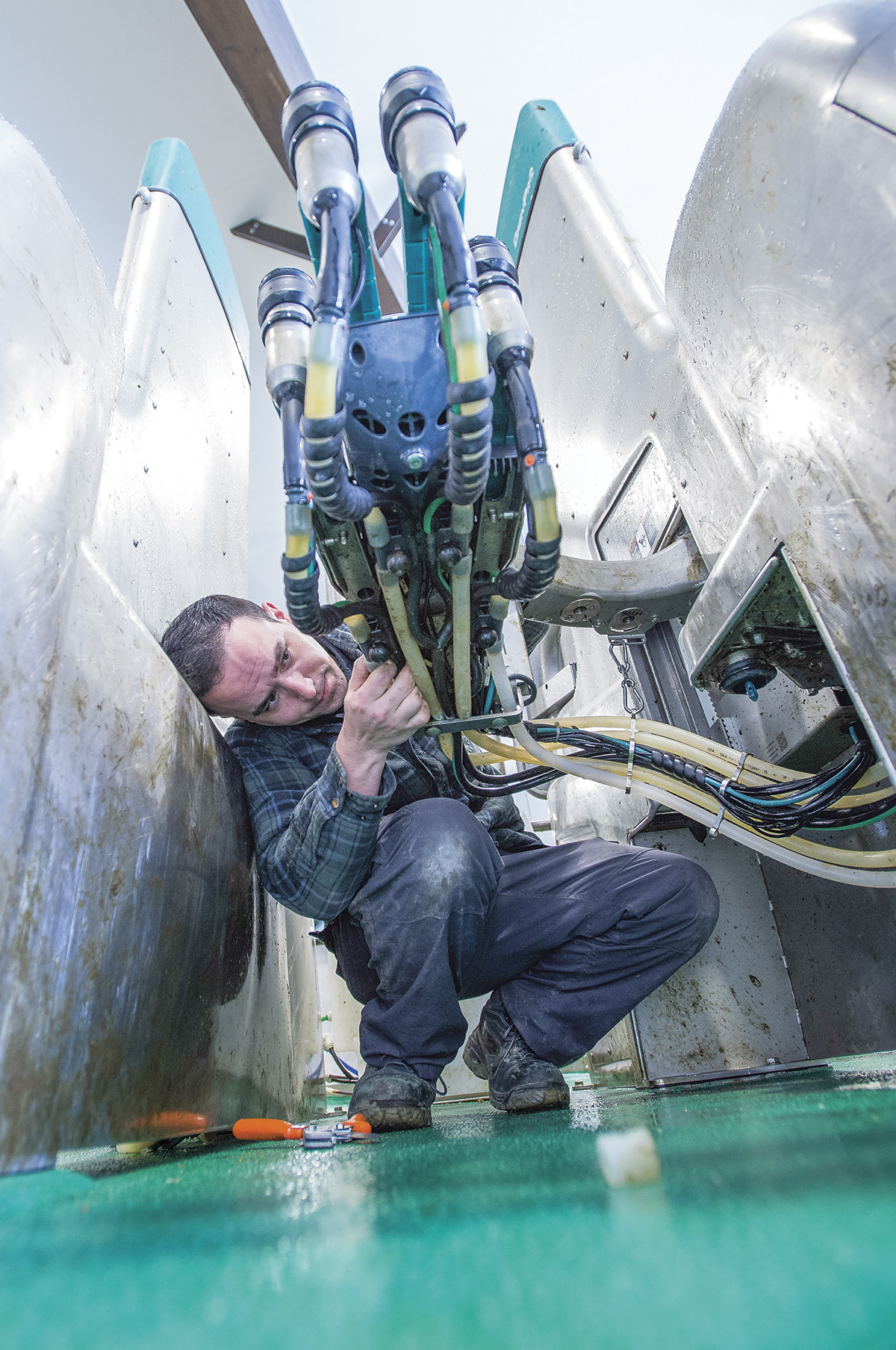What happens when your internet isn’t working? You’re probably not going to call your internet provider immediately. Instead, after some cursing and dusting off the barn grime, you might check your router, disconnect and reconnect your modem, check if there’s an outage or restart your device.
With some simple troubleshooting steps, you can discover the problem and fix it yourself or determine if a service call is needed. The same applies when servicing a robotic milking system.
Servicing and troubleshooting robots can be one of the biggest adjustments for anyone new to robotic milking. Digging in and doing some preliminary troubleshooting yourself, before making a service call to your dealer, can save a lot of time and often prevent an emergency service call (and the corresponding bill) down the road.
Learn as you go
The first year with a robotic system comes with the biggest learning curve in terms of understanding the system and knowing what to look for when performing maintenance.
When your service technician is there to work on the robot, always involve yourself. Be there to greet them when they arrive at the farm, show them what you are seeing, and don’t hesitate to ask questions. You can learn how to identify the most common equipment hurdles and how to work through them.
It’s also helpful to educate your team on how the robot interfaces with cows and data. Understanding how the cows come into the stall and how the ID system, data transfer and milk handling works will give you better insight into what part of the equipment might not be functioning properly when an issue arises.
Performing regular maintenance at planned intervals will also help build the confidence you and your team need to troubleshoot and make some repairs in emergency situations.
Start with what you know
At first glance, troubleshooting issues with a robotic milking system may seem complicated. In reality, most of your maintenance needs will be similar to conventional milking.
When facing a robotic milking issue, start troubleshooting steps the same way you would with a conventional milking system, but review the alarm list to help direct you where to go. Look over your milking stall and make sure liners are seated properly in the shells, hoses are connected properly, and cluster movements are functioning normally. Evaluate your hoses to see if you have a torn milk tube or pulsation hose.
Once you understand the different systems and issues you could run into with a robotic system, troubleshooting will become as second nature as a conventional milking system.
 When facing a robotic milking issue, start troubleshooting steps the
same way you would with a conventional milking system. Look over your
milking stall and make sure liners are seated properly in the shells,
hoses are connected properly, and cluster movements are functioning
normally. Photo courtesy of GEA.
When facing a robotic milking issue, start troubleshooting steps the
same way you would with a conventional milking system. Look over your
milking stall and make sure liners are seated properly in the shells,
hoses are connected properly, and cluster movements are functioning
normally. Photo courtesy of GEA.
Don’t ignore alerts
Rely on your robot alerts to give you a better idea of where the issue might be occurring. For example, an alert about too many incomplete milkings typically indicates a mechanical issue, such as a disconnected pulsation hose or twisted liner. Or if you have a high number of kickoffs, you might have a failed kickoff sensor reporting false kickoffs, and you can run a kickoff test to check.
It’s also important to address alerts when they happen. If you receive a notification, the problem isn’t going to fix itself. And if you clear the alert without investigating, you may end up with an emergency service call down the road when a simple fix up-front could have prevented a larger issue.
Keep an eye on robot performance
Maintenance issues aren’t always as obvious as a robot unit not milking cows. Sometimes, the robot is working but it could be working better. Things like increased attachment time, high box times or wash problems can improve with simple troubleshooting and attention to detail.
Reviewing your wash quality and machine performance data is a good way to reveal any issues. Start by setting machine performance benchmarks and review system reports daily to ensure you’re staying on target. Work with your dealer to better understand what to look for in the reports.
On-point and on-time proactive maintenance can also go a long way toward keeping machine performance running smoothly. Doing the little things right each day – maintaining the hose package, changing liners on time, checking pulsators, rinsing off any moving parts, ensuring the camera cleaning routine is done on schedule – can save you a lot of headaches in the long term.
It takes a team effort
Like any milking system, it takes a strong team to ensure your robots perform their best and equipment performance issues are taken care of quickly with minimal downtime.
Start by building a good relationship with your dealer service team. Proactive communication around your farm goals and when and how to bring in your technician will make service calls go smoothly, especially in an emergency.
And you don’t want to rely on only one service technician to understand your system. Communicate with your dealer about creating a service team and ensure your on-farm team (employees, maintenance team, farm manager, etc.) understands the system and is updated on protocols.
It will take time, but through a better understanding of your robotic system, building a strong relationship with your dealer service team and being consistent with proactive maintenance, you will be successful in troubleshooting and servicing your robotic milking system.






